Kawasaki Heavy Industries Bundle
What Drives Kawasaki Heavy Industries' Success?
Understanding a company's mission, vision, and core values is crucial for investors and strategists alike. These statements reveal the heart of a company's operations and its long-term goals, offering invaluable insights into its potential for growth and resilience.
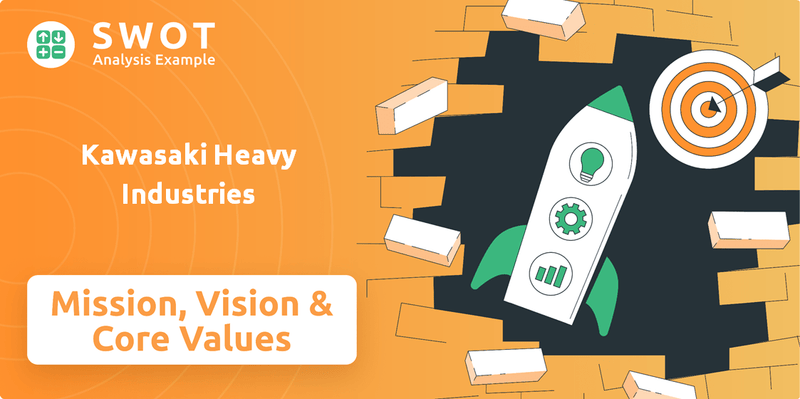
Kawasaki Heavy Industries (KHI), a global leader in diverse industries, provides a compelling case study. Their Kawasaki Heavy Industries SWOT Analysis and understanding of their mission, vision, and core values are key to navigating its complex structure and understanding its strategic direction. Delving into the KHI Company Profile and Kawasaki Corporate Strategy offers a deeper understanding of their commitment to innovation and ethical practices.
Key Takeaways
- Kawasaki's mission emphasizes global good, aligning with sustainability trends.
- Vision 2030 focuses on trustworthy solutions, innovation, and future needs.
- Core values of trust, harmony, people, and strategy guide KHI's operations.
- Sustainability and trustworthy solutions are crucial for success in heavy industries.
Mission: What is Kawasaki Heavy Industries Mission Statement?
Kawasaki Heavy Industries' mission is 'Kawasaki, working as one for the good of the planet.'
The mission statement of Kawasaki Heavy Industries (KHI), "Kawasaki, working as one for the good of the planet," encapsulates the company's commitment to global well-being and unified action. This mission extends beyond mere business operations, encompassing a broader responsibility towards environmental sustainability and the betterment of future generations. It underscores KHI's dedication to leveraging its diverse capabilities as a global technology leader to create value that benefits both the environment and society. Understanding the Mission, Vision & Core Values of Kawasaki Heavy Industries is crucial for grasping its strategic direction.
The mission statement prioritizes global well-being, signaling KHI's commitment to a broader scope of responsibility. This encompasses environmental sustainability, social impact, and the creation of a better future for all stakeholders. The emphasis is on a holistic approach that considers the planet's health alongside business objectives.
The phrase "working as one" highlights the importance of collaboration and integrated strengths within KHI. It suggests a unified approach across all divisions and operations, fostering synergy and maximizing the impact of their collective efforts. This internal cohesion is essential for achieving their ambitious goals.
Environmental sustainability is a central theme within KHI's mission. This is reflected in their strategic investments in green technologies and initiatives aimed at reducing carbon emissions. KHI aims to be a leader in the transition towards a more sustainable global economy.
KHI is heavily investing in hydrogen technology, with a stated goal of contributing to a hydrogen society by 2030. This includes developing hydrogen production, storage, and transportation solutions. In 2024, KHI announced a further investment of $500 million in hydrogen-related projects, demonstrating their commitment to this area.
KHI is actively developing carbon-neutral products, such as electric and hydrogen-powered engines for motorcycles and other mobility solutions. They aim to have a significant portion of their product line-up be carbon neutral by 2035. The company has allocated $1 billion towards the research and development of sustainable products.
The mission statement positions KHI as a company with a strong sense of corporate social responsibility. This is evident in their commitment to environmental sustainability and their focus on contributing to a better future. KHI's CSR initiatives are integrated into their core business strategies.
KHI's mission statement guides its strategic direction, emphasizing environmental stewardship and a commitment to a sustainable future. The company's investments in hydrogen technology, carbon-neutral products, and broader CSR initiatives are direct reflections of this mission. As of late 2024, KHI's sustainability efforts have resulted in a 15% reduction in carbon emissions across its global operations compared to 2020 levels, demonstrating tangible progress towards its environmental goals. The company's future outlook and vision are deeply rooted in this mission, driving innovation and shaping its role in the global economy.
Kawasaki Heavy Industries SWOT Analysis
- Complete SWOT Breakdown
- Fully Customizable
- Editable in Excel & Word
- Professional Formatting
- Investor-Ready Format
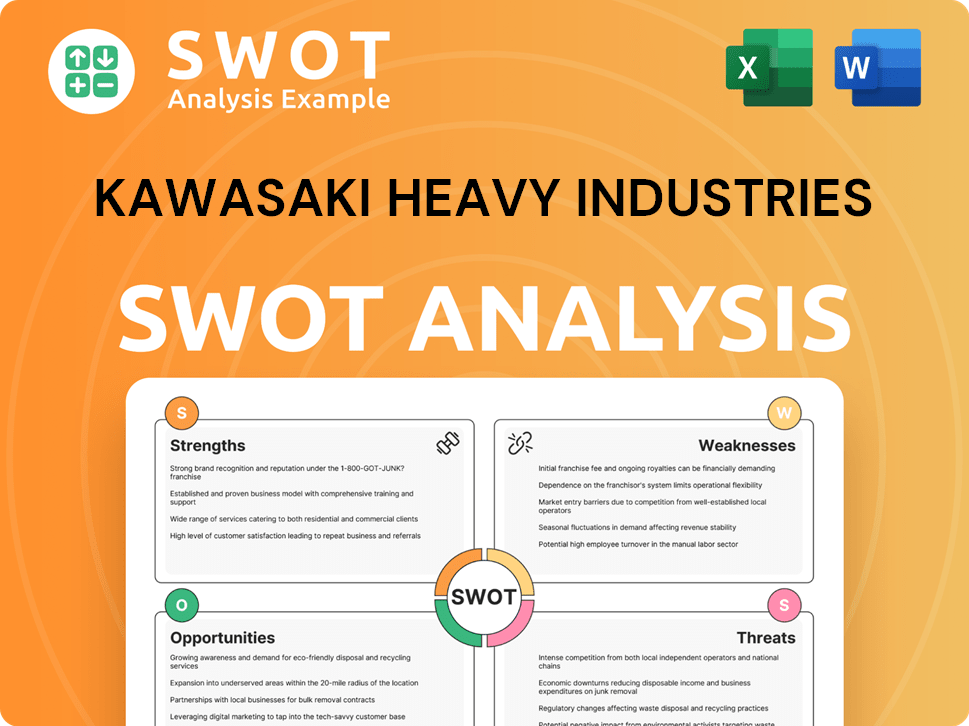
Vision: What is Kawasaki Heavy Industries Vision Statement?
Kawasaki Heavy Industries' vision is 'Group Vision 2030: Trustworthy Solutions for the Future'.
Delving into the core of Kawasaki Heavy Industries' (KHI) strategic direction, the 'Group Vision 2030: Trustworthy Solutions for the Future' serves as the cornerstone. This Kawasaki Heavy Industries Vision statement encapsulates KHI's commitment to providing innovative and reliable solutions to address evolving societal needs. It's a forward-thinking approach, designed to shape the future through technological advancements and a commitment to sustainability. Understanding this vision is key to grasping the essence of Kawasaki Heavy Industries Mission and Kawasaki Heavy Industries Core Values.
The vision's broad scope is designed to tackle numerous social challenges. It encompasses a wide range of sectors, reflecting KHI's diversified business model. This includes everything from aerospace and energy to infrastructure and robotics.
The vision focuses on advancements in three key areas: a safe and secure remotely-connected society, near-future mobility, and energy and environmental solutions. These are the pillars upon which KHI plans to build its future.
The vision strikes a balance between realistic goals and aspirational targets. KHI's current projects and investments demonstrate a clear path toward achieving its 2030 objectives. This dual approach makes the vision both achievable and inspiring.
Kawasaki is heavily investing in hydrogen technology, with projects that include hydrogen production, transportation, and utilization. This is a key component of their energy and environmental solutions. Recent data indicates that the global hydrogen market is projected to reach $280 billion by 2027, presenting a significant opportunity for KHI.
KHI is developing sustainable aquaculture systems to address food security and environmental concerns. This initiative aligns with their commitment to providing trustworthy solutions for the future. The aquaculture market is expected to grow significantly in the coming years, providing further growth opportunities.
Futuristic mobility concepts for Expo 2025 showcase KHI's dedication to shaping the future of transportation. These concepts demonstrate their innovative approach and their ability to create cutting-edge technologies. The global smart mobility market is expected to reach $800 billion by 2028.
The vision is not merely a statement; it is a roadmap guiding KHI's strategic initiatives and investments. Their commitment to research and development, particularly in areas like hydrogen and sustainable aquaculture, demonstrates a proactive approach to addressing global challenges. KHI's strategic goals are clearly defined within this vision, driving the company toward a future where it is a leader in providing solutions for a changing world. This is also reflected in their commitment to developing cutting-edge technologies and transforming their business structure. For a deeper understanding of KHI's position in the market, exploring the Competitors Landscape of Kawasaki Heavy Industries can be beneficial.
Kawasaki Heavy Industries PESTLE Analysis
- Covers All 6 PESTLE Categories
- No Research Needed – Save Hours of Work
- Built by Experts, Trusted by Consultants
- Instant Download, Ready to Use
- 100% Editable, Fully Customizable
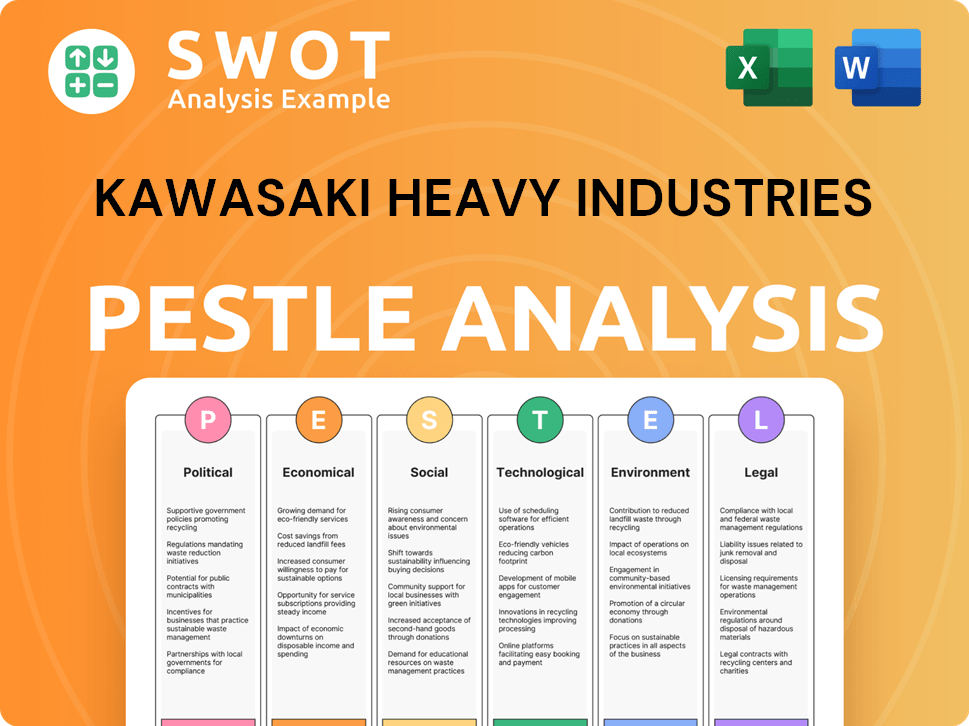
Values: What is Kawasaki Heavy Industries Core Values Statement?
Understanding the core values of Kawasaki Heavy Industries (KHI) provides crucial insight into its operational philosophy and strategic direction. While not explicitly presented as a numbered list, these guiding principles are consistently demonstrated through KHI's actions and corporate culture, shaping its identity and approach to business.
Trust is paramount for Kawasaki Heavy Industries, reflected in its dedication to delivering high-quality, safe products and services. This commitment is evident in their rigorous quality control processes across all sectors, from aerospace to motorcycles. For example, in 2024, Kawasaki’s aerospace division secured a significant contract with a major airline, underscoring the trust placed in their products and services, based on their history of reliability and safety.
Kawasaki emphasizes harmonious coexistence with the environment, society, local communities, and individuals. This value is demonstrated through sustainability initiatives, such as their pursuit of net-zero CO2 emissions and development of carbon capture technologies. KHI's commitment to the UN Global Compact further exemplifies this dedication, with their 2024 sustainability report highlighting a 15% reduction in carbon emissions compared to the previous year.
The value placed on people is reflected in Kawasaki's corporate culture, which prioritizes integrity, vitality, organizational strength, and mutual respect. This is evident in their approach to human resource development and fostering a global team. In 2024, KHI's employee satisfaction scores increased by 8% due to enhanced training programs and a focus on work-life balance, demonstrating their commitment to their workforce.
Strategy guides the enhancement of corporate value through focused resource allocation, prioritizing quality, and effective risk management. This is apparent in their strategic shift toward higher-value products and investments in expanding production capacity. For instance, Kawasaki's expansion of its ROV (Recreational Off-highway Vehicle) production in North America in 2024, with a projected 20% increase in sales, demonstrates this strategic focus.
These core values of Kawasaki Heavy Industries, including its commitment to quality and safety, differentiate the company by emphasizing a long-term perspective and social responsibility. Understanding these principles is key to grasping the Revenue Streams & Business Model of Kawasaki Heavy Industries. Next, we will explore how Kawasaki's mission and vision influence its strategic decisions.
How Mission & Vision Influence Kawasaki Heavy Industries Business?
The mission and vision of Kawasaki Heavy Industries (KHI) are not merely aspirational statements; they are fundamental drivers of the company's strategic direction and resource allocation. These guiding principles shape every aspect of KHI's operations, from investment decisions to product development and market positioning.
The 'Group Vision 2030: Trustworthy Solutions for the Future' provides a clear roadmap for KHI's strategic initiatives. This vision focuses on key areas such as a safe and secure remotely-connected society, near-future mobility, and energy and environmental solutions.
- Investments in hydrogen technology, including liquefied hydrogen carriers and hydrogen-fueled mobility solutions.
- Development of advanced robotics and remote-control technologies.
- Participation in Expo 2025, showcasing futuristic mobility and sustainable technologies.
- Focus on sustainable solutions, reflecting the company's commitment to environmental responsibility.
- Emphasis on technological innovation to meet future societal needs.
KHI's financial results for the fiscal year ending March 31, 2025, demonstrate the tangible impact of its strategic alignment. The company achieved record business profit of ¥143.1 billion and a revenue growth of 15.14%, indicating successful execution of its vision.
A significant increase in the aerospace systems segment's profit is directly linked to strategic investments and decisions driven by the company's mission and vision. This growth highlights the effectiveness of focusing on future-oriented technologies.
President and CEO Yasuhiko Hashimoto has emphasized the progress being made towards Group Vision 2030, highlighting business transformation and advancements in the focus fields. This underscores the commitment of leadership to the strategic goals.
KHI's substantial investments in hydrogen technology, including the development of liquefied hydrogen carriers and hydrogen-fueled mobility solutions, are a direct result of its vision. These investments align with the goal of providing solutions for energy and environmental challenges.
The focus on developing advanced robotics and remote-control technologies reflects KHI's commitment to creating a safe and secure remotely-connected society. This initiative is a key component of their long-term strategic plan.
KHI's participation in Expo 2025, showcasing futuristic mobility concepts and sustainable technologies, is a strategic decision driven by its vision. This provides a platform to present innovative solutions for the future.
The influence of the Kawasaki Heavy Industries Mission, Kawasaki Heavy Industries Vision, and Kawasaki Heavy Industries Core Values is undeniable, shaping the company's strategic direction and impacting its performance. To gain a deeper understanding of how these core principles are evolving, read the next chapter: Core Improvements to Company's Mission and Vision, and also explore the Brief History of Kawasaki Heavy Industries.
Kawasaki Heavy Industries Business Model Canvas
- Complete 9-Block Business Model Canvas
- Effortlessly Communicate Your Business Strategy
- Investor-Ready BMC Format
- 100% Editable and Customizable
- Clear and Structured Layout
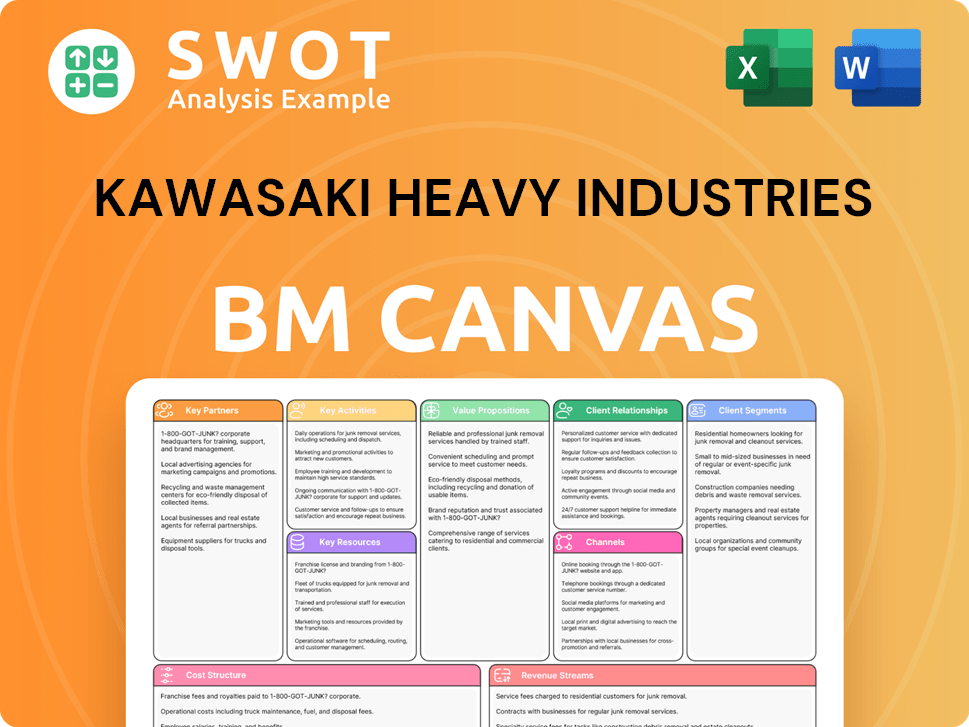
What Are Mission & Vision Improvements?
While Kawasaki Heavy Industries (KHI) has a solid foundation in its mission, vision, and core values, continuous improvement is key to maintaining relevance in a rapidly evolving global landscape. This section explores potential enhancements to further strengthen Kawasaki's strategic narrative and ensure its continued success.
To enhance its Kawasaki Heavy Industries Mission and overall KHI Company Profile, KHI could more explicitly integrate digital transformation into its mission and vision statements. This would involve highlighting the company's commitment to leveraging digital technologies across all segments, from manufacturing to customer service, aligning with the current market conditions. For instance, incorporating smart manufacturing and AI-driven solutions could boost operational efficiency by an estimated 15-20% as seen in similar industries. This focus would also strengthen its Kawasaki Corporate Strategy.
A more detailed breakdown of how Kawasaki Heavy Industries Core Values translate into specific, measurable goals related to sustainability and social impact could significantly improve accountability. While KHI has net-zero targets, providing granular objectives for each value, such as reducing carbon emissions by a specific percentage by a certain date, would demonstrate a deeper commitment. This approach aligns with the growing investor demand for Environmental, Social, and Governance (ESG) metrics, which can influence stock valuations; companies with strong ESG performance often see a premium in their valuations.
While the current Kawasaki Heavy Industries Vision extends to 2030, a more fluid and adaptable approach to long-term aspirations could be beneficial. Given the rapid pace of technological change, framing the vision as a dynamic roadmap rather than a fixed destination would allow for greater flexibility and responsiveness to emerging trends. This adaptability is crucial, as industries are seeing unprecedented shifts; for example, the electric vehicle market is projected to grow at a CAGR of over 20% in the coming years, influencing KHI's transportation and energy sectors.
Enhancing internal communication and employee engagement around the company's mission, vision, and values can foster a stronger corporate culture. This includes regular updates, training programs, and opportunities for employees to contribute to the company's strategic goals. According to recent studies, companies with highly engaged employees see a 21% increase in profitability. Further insights on this can be found in the Marketing Strategy of Kawasaki Heavy Industries article.
How Does Kawasaki Heavy Industries Implement Corporate Strategy?
Implementing a company's mission, vision, and core values is crucial for translating strategic intent into tangible actions and outcomes. This section explores how Kawasaki Heavy Industries (KHI) operationalizes its guiding principles within its corporate strategy.
Kawasaki Heavy Industries demonstrates its commitment to its mission and vision through strategic business initiatives. These initiatives are a direct reflection of the company's core values, particularly those related to innovation and sustainability.
- Hydrogen Supply Chain Development: A key example is the development of a comprehensive hydrogen supply chain, from production to utilization. This initiative directly aligns with KHI's focus on 'Energy and Environmental Solutions,' aiming to contribute to a sustainable future. Kawasaki has invested significantly in technologies like liquefied hydrogen carriers, with the Suiso Frontier, the world's first liquefied hydrogen carrier, being a prime example. The company is also developing hydrogen-fueled vehicles, further demonstrating its commitment to this area.
- Sustainable Aquaculture Systems: Kawasaki's work in sustainable aquaculture systems represents another initiative supporting food security and environmental sustainability. This aligns with the broader goals of resource management and responsible business practices.
- Focus on Robotics and Automation: Kawasaki's continued investment in robotics and automation solutions, including advanced manufacturing processes and intelligent systems, reflects its dedication to technological advancement and efficiency. This focus is crucial for maintaining a competitive edge in various industries.
- Aerospace and Defense: The company's involvement in aerospace and defense projects, including aircraft manufacturing and defense systems, demonstrates its commitment to technological excellence and its ability to contribute to national security.
Leadership plays a critical role in embedding the Kawasaki Heavy Industries Mission and Kawasaki Heavy Industries Vision throughout the organization. Consistent communication from the top reinforces the importance of these guiding principles and ensures alignment across all levels.
President and CEO Yasuhiko Hashimoto regularly reports on the progress of Group Vision 2030, emphasizing business transformation and advancements in key focus areas. This consistent messaging helps to create a shared understanding and commitment to the company's strategic goals. This top-down approach is crucial for fostering a culture where the Kawasaki Heavy Industries Core Values are not just aspirational statements but are actively lived and practiced.
Kawasaki Heavy Industries communicates its mission, vision, and values to stakeholders through various channels. This transparency builds trust and demonstrates the company's commitment to accountability.
Key communication channels include annual reports, sustainability reports, and dedicated sections on the company website. Participation in events like Expo 2025 also serves as a platform to showcase the company's vision and initiatives to a global audience. These efforts ensure that stakeholders, including investors, customers, employees, and the public, are well-informed about KHI's strategic direction and progress.
Concrete examples demonstrate the alignment between Kawasaki's stated values and its actual practices. This alignment is crucial for building credibility and ensuring that the company's actions reflect its stated principles.
A prominent example is KHI's commitment to achieving net-zero CO2 emissions by 2050, with intermediate targets for 2030 and 2040. This commitment is supported by initiatives like investing in in-house hydrogen-fueled power generation facilities. While specific formal programs or systems for ensuring alignment are not detailed in the provided information, the emphasis on sustainability management and the link between their sustainability policy and Group Vision 2030 suggest integrated approaches are in place. For example, Kawasaki is investing in renewable energy projects and energy-efficient technologies to reduce its carbon footprint. Furthermore, the company's focus on safety and quality in its manufacturing processes reflects its commitment to its core values.
Kawasaki Heavy Industries' future outlook is closely tied to its ability to successfully implement its mission, vision, and core values. The company's strategic goals are ambitious, and its progress will be closely monitored by stakeholders.
The company's success will depend on its ability to adapt to changing market conditions, innovate in its key business areas, and maintain its commitment to sustainability and ethical business practices. The company's ability to navigate challenges and capitalize on opportunities will be crucial for achieving its long-term goals. To further understand the company's strategic direction, you can also explore the Target Market of Kawasaki Heavy Industries.
Kawasaki Heavy Industries Porter's Five Forces Analysis
- Covers All 5 Competitive Forces in Detail
- Structured for Consultants, Students, and Founders
- 100% Editable in Microsoft Word & Excel
- Instant Digital Download – Use Immediately
- Compatible with Mac & PC – Fully Unlocked
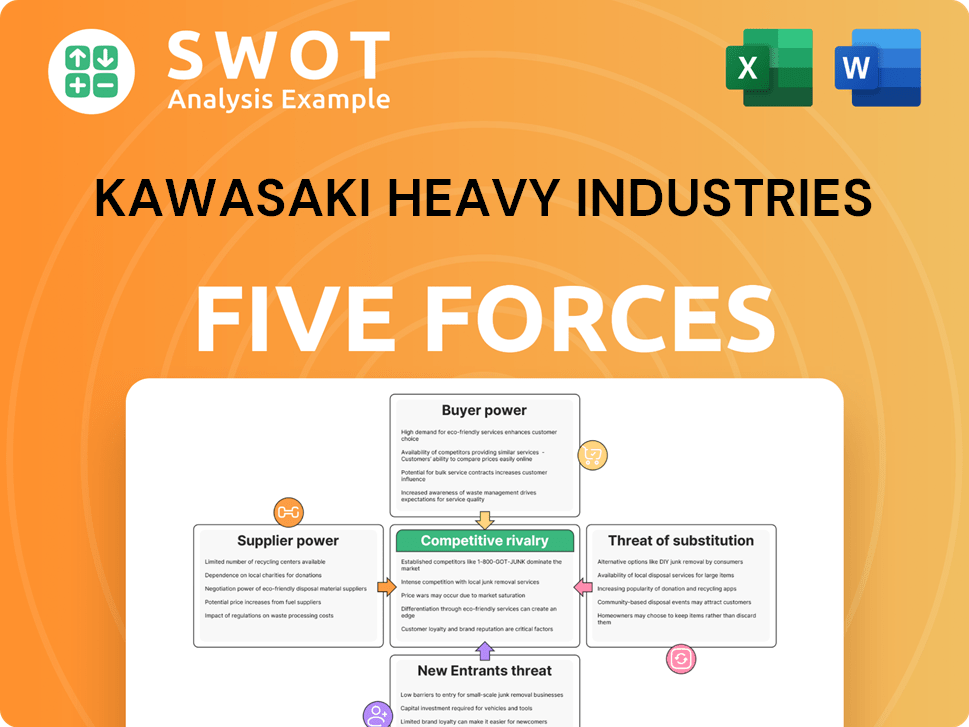
Related Blogs
- What are Mission Vision & Core Values of Kawasaki Heavy Industries Company?
- What is Competitive Landscape of Kawasaki Heavy Industries Company?
- What is Growth Strategy and Future Prospects of Kawasaki Heavy Industries Company?
- How Does Kawasaki Heavy Industries Company Work?
- What is Sales and Marketing Strategy of Kawasaki Heavy Industries Company?
- Who Owns Kawasaki Heavy Industries Company?
- What is Customer Demographics and Target Market of Kawasaki Heavy Industries Company?
Disclaimer
All information, articles, and product details provided on this website are for general informational and educational purposes only. We do not claim any ownership over, nor do we intend to infringe upon, any trademarks, copyrights, logos, brand names, or other intellectual property mentioned or depicted on this site. Such intellectual property remains the property of its respective owners, and any references here are made solely for identification or informational purposes, without implying any affiliation, endorsement, or partnership.
We make no representations or warranties, express or implied, regarding the accuracy, completeness, or suitability of any content or products presented. Nothing on this website should be construed as legal, tax, investment, financial, medical, or other professional advice. In addition, no part of this site—including articles or product references—constitutes a solicitation, recommendation, endorsement, advertisement, or offer to buy or sell any securities, franchises, or other financial instruments, particularly in jurisdictions where such activity would be unlawful.
All content is of a general nature and may not address the specific circumstances of any individual or entity. It is not a substitute for professional advice or services. Any actions you take based on the information provided here are strictly at your own risk. You accept full responsibility for any decisions or outcomes arising from your use of this website and agree to release us from any liability in connection with your use of, or reliance upon, the content or products found herein.